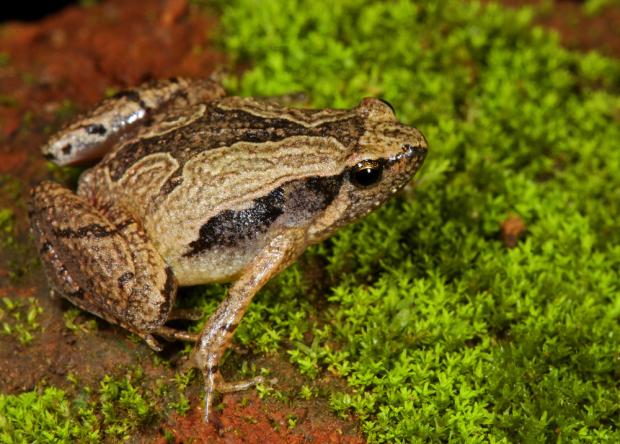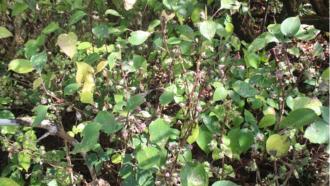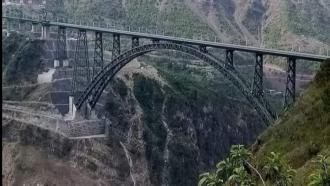
Photo: Dr. Aravind N A/ Research Matters
This endangered frog was under-studied for 16 years and previously known from only two locations.
A team of frog enthusiasts, including scientists from Gubbi Labs, Ashoka Trust for Research in Ecology and the Environment (ATREE) - Bengaluru and the National University of Singapore (NUS), have uncovered a widespread population of the endangered Sholiga Narrow Mouthed Frog (Microhyla sholigari) along the west coast of India. Rtd, Prof. Sushil Kumar Dutta of the Utkal University, Orissa and P. Ray of the Regional Museum of Natural History had originally described this tiny frog, measuring up to 1.7 cm, from the Biligiri Rangaswamy Temple Tiger Reserve (BRTTR) in the year 2000.
The Sholiga Narrow Mouthed frog belongs to a group known as ‘microhylids’, Greek for “narrow mouth”. Currently, there are 39 known species in this genus and are widespread across the South and South East Asia. Ever since its description, the Sholiga Narrow Mouthed frog remained a mystery to most biologists until a group of frog enthusiasts stumbled upon a microhylid frog in the town of Bisle during the monsoon of 2015.
During the monsoon months of 2012, Ms. Deepika Prasad, an IT professional, rounded up a group of citizens from all walks of life and decided to meet in the small town of Bisle, in the Western Ghats. Calling themselves the “Bisle frog-watch team”, they have, for the last four years, spent two nights each monsoon, searching for frogs in the company of trained researchers. In 2012, Dr. Gururaja K V, a well-known amphibian researcher, was invited to join the team. Subsequently, Mr. Seshadri K S, who has been researching frogs in the Western Ghats, joined them in the year 2015. That is when they stumbled upon this frog, entirely by accident. “Initially, we did not expect to see a frog as the call was sounding like a cricket. But we persisted and looked carefully to see a small microhylid frog calling among the grass”, recalls Mr. Seshadri, a PhD candidate at NUS.
In 2013, another group of researchers based at the Ashoka Trust for Research in Ecology and the Environment (ATREE) and Gubbi Labs, accidentally found this frog in the kitchen of their field station in BRTTR. They too were aware of the knowledge gap in describing this species and were working on re-describing it. Dr. Gururaja and Mr. Seshadri joined hands with ATREE and got Mr. Ramit Singal, an engineer turned conservationist based out of Manipal, Mangaluru and Mr. Vineeth Kumar, a PhD candidate at the Mangaluru University, both of whom had encountered this mystery frog along the Western Ghats, on board.
“The identity of this frog was a mystery because the original description did not have good photographs, the measurements were made on non-adult specimens and there was no description of the call pattern. Essentially, there was very little information available to deduce the identity of the mystery frog we had at hand”, adds Dr. Gururaja.
The team soon got to work and put together the locations at which this mystery frog was found. They collected a few specimens and began to measure them carefully. Ms. Priti, a PhD candidate at ATREE, performed the molecular analysis using the DNA of this frog. After comparing the measurements with the original descriptions and on the basis of the DNA analysis, the researchers concluded that the mystery frog at hand was M. sholigari and reported the discovery in the recent issue of the taxonomy journal Zootaxa.
The study reports that M. sholigari is now widespread across an area of 28,000 km2 as compared to the earlier information from two localities alone, and has been found in about 15 new locations, including the Bannerghatta National Park, Bengaluru. It was previously listed as ‘Endangered’ based on the guidelines provided by the International Union of Conservation of Nature (IUCN) since it was found only in two locations of the Western Ghats. “However, with the reassessment provided in the study, we suggested that M. sholigari can now be down-listed to ‘Least Concerned’ as none of the IUCN criteria are met”, claims Dr. Gururaja.
“There are several challenges in understanding biodiversity. For example, we lack basic knowledge like the appearance or call of several species. Observing and carefully making natural history notes is the only way to fill this gap”, says Mr. Seshadri citing the need for re-description and detailed studies. “Engaging citizens in this activity will help in more ways than one because nature enthusiasts are everywhere and in today’s world, networking is easy. We believe our case of engaging citizens in scientific pursuits, which led to the re-assessment and re-description of the Sholiga Narrow Mouthed frog, is an important way forward to understanding and eventually conserving biodiversity” he adds.
About the research:
The team comprised of Mr. Seshadri K S, Ms. Priti H, Mr. Ravikanth G, Ms. Vidisha M K, Mr. Vineeth K K, Mr. Ramit Singal, Mr. Sarma R R, Mr. Aravind N A and Dr. Gururaja K V. The paper appeared on the 21st December 2016 issue of Zootaxa. A snapshot of the paper can be found here: http://www.mapress.com/j/zt/article/view/zootaxa.4208.6.3/9719. Additional media content available upon request
Contact Information:
Mr. Seshadri KS, PhD Student, National University of Singapore, seshadri@u.nus.edu, 9481029488.
Ms. Priti H, Senior Research Fellow, ATREE, priti.gururaj@atree.org, 9481789157
Dr. Gururaja KV*, Chief Scientist Gubbi Labs, gururaja@gubbilabs.in, 9480187502
* Now Faculty with Srishti Institute.

























